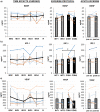Chronic, acute and protocol-dependent effects of exercise on psycho-physiological health during long-term isolation and confinement
- PMID: 35773633
- PMCID: PMC9244384
- DOI: 10.1186/s12868-022-00723-x
Chronic, acute and protocol-dependent effects of exercise on psycho-physiological health during long-term isolation and confinement
Abstract
Exercise could prevent physical and psychological deteriorations, especially during pandemic times of lock-down scenarios and social isolation. But to meet both, the common exercise protocols require optimization based on holistic investigations and with respect to underlying processes. This study aimed to explore individual chronic and acute effects of continuous and interval running exercise on physical and cognitive performance, mood, and affect and underlying neurophysiological factors during a terrestrial simulated space mission. Six volunteers (three females) were isolated for 120 days. Accompanying exercise training consisted of a continuous and interval running protocol in a cross-over design. Incremental stage tests on a treadmill were done frequently to test physical performance. Actigraphy was used to monitor physical activity level. Cognitive performance, mood (MoodMeter®), affect (PANAS), brain-derived neurotrophic factor (BDNF), insulin-like growth factor 1 (IGF-1), vascular-endothelial growth factor (VEGF), and saliva cortisol were investigated prior to, four times during, and after isolation, pre- and post-exercise on two separate days, respectively. As a chronic effect, physical performance increased (and IGF-1 tended) in the course of isolation and training until the end of isolation. Subjective mood and affect state, as well as cognitive performance, basal BDNF and VEGF levels, were well-preserved across the intervention. No acute effects of exercise were detected, besides slower reaction time after exercise in two out of nine cognitive tests, testing sensorimotor speed and memory of complex figures. Consistently higher basal IGF-1 concentrations and faster reaction time in the psychomotor vigilance test were found for the continuous compared to the interval running protocol. The results suggest that 120 days of isolation and confinement can be undergone without cognitive and mental deteriorations. Regular, individual aerobic running training supporting physical fitness is hypothesized to play an important role in this regard. Continuous running exercise seems to trigger higher IGF-1 levels and vigilance compared to interval running. Systematic and prolonged investigations and larger sample size are required to follow up on exercise-protocol specific differences in order to optimize the exercise intervention for long-term psycho-physiological health and well-being.
Keywords: Affect; Cognitive performance; Cortisol; Mental Health; Mood; Neurotrophic Factors; Physical Activity.
© 2022. The Author(s).
Conflict of interest statement
The authors declare no competing interests.
Figures









References
-
- De La Torre GG, van Baarsen B, Ferlazzo F, Kanas N, Weiss K, Schneider S, et al. Future perspectives on space psychology: Recommendations on psychosocial and neurobehavioural aspects of human spaceflight. Acta Astronaut. 2012;81(2):587–599. doi: 10.1016/j.actaastro.2012.08.013. - DOI
-
- Affect NK. In: Encyclopedia of Behavioral Medicine. Gellman MD, Turner JR, editors. New York: Springer; 2013. pp. 49–50.
-
- Sauer J, Hockey GR, Wastell DG. Performance evaluation in analogue space environments: adaptation during an 8-month Antarctic wintering-over expedition. Aviat Space Environ Med. 1999;70(3 Pt 1):230–235. - PubMed
-
- Reed HL, Reedy KR, Palinkas LA, Van Do N, Finney NS, Case HS, et al. Impairment in cognitive and exercise performance during prolonged antarctic residence: effect of thyroxine supplementation in the polar triiodothyronine syndrome. J Clin Endocrinol Metab. 2001;86(1):110–116. - PubMed
Publication types
MeSH terms
Substances
LinkOut - more resources
Full Text Sources
Research Materials
Miscellaneous

